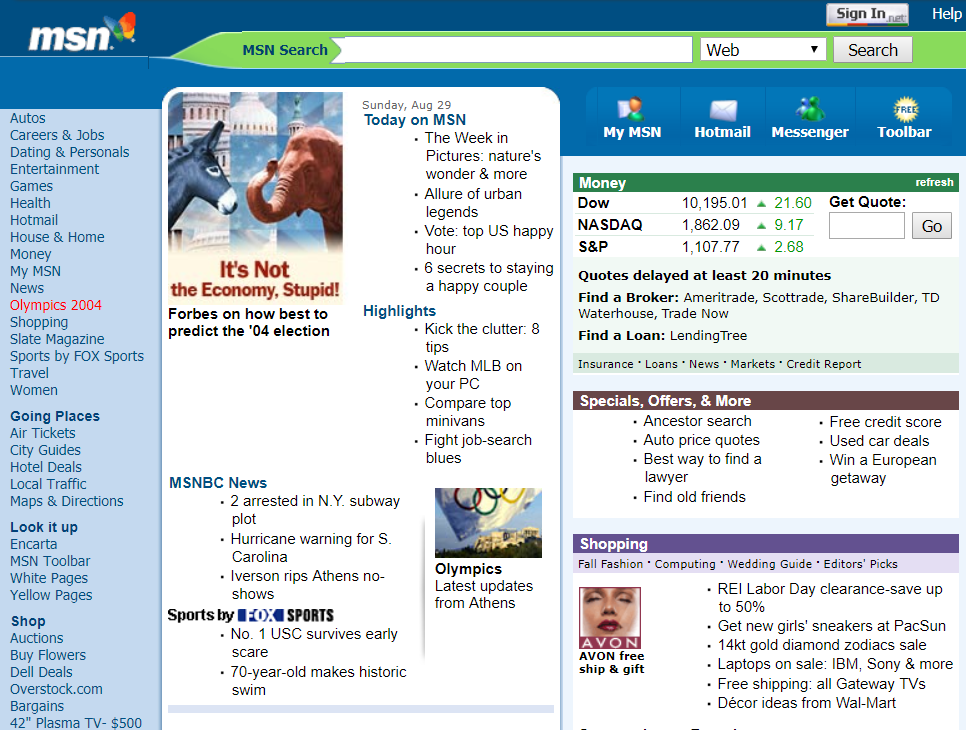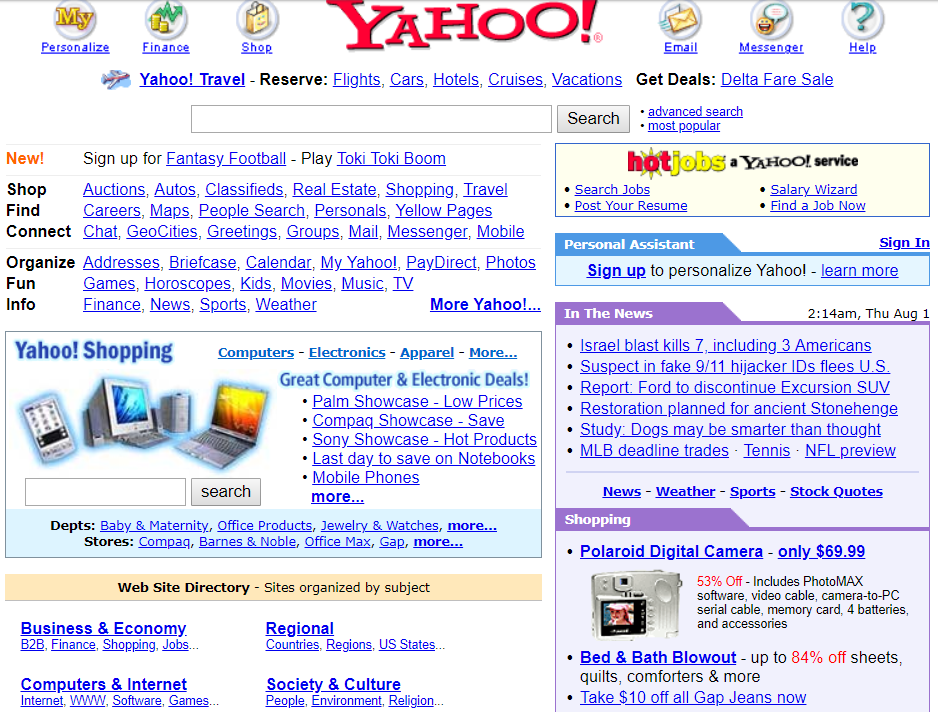Imagine that I’m throwing tennis balls at you.
I’m standing in front of you with 10 of them and despite the obvious physical restrictions, I’m preparing to throw all of them at you at the same time.
If I was able to chuck all of them at you at the same time, how many do you think you’d be able to catch?

Unless you’re superhuman, you’d be lucky to catch just one. This is because it’s incredibly difficult to focus on any of them (as they all fly at you at the same time).
Now imagine that I’m standing in front of you with those same 10 tennis balls, but instead of performing the near impossible physical task of throwing all 10 at the same time, I throw one at a time.

In this circumstance, it’s probable that you’ll catch all of them (provided you have decent hand-eye coordination).
Now transfer this principle to your advertising/marketing campaigns:
How many tennis balls/messages are you throwing at the same time? And what chance has your target market got of catching them?
This simple difference proves the theory of Goal Dilution, a psychological factor that you must take into account when putting together your advertising and marketing campaigns.
Contents
What is Goal Dilution?
Goal dilution theory has proven that the more singular and focussed something is, the better we believe it to be at this one trait/purpose, and alternatively, the more that trait is diluted amongst others, the less good we believe it to be (even though it isn’t).
For example, imagine there are two identical shops and both sell the exact same quality of sweets:
- Shop A only sells sweets.
- Shop B sells sweets, ice cream, cake and pastries

The theory of goal dilution states that even though the sweets are exactly the same quality at both places, you’d think that the sweets at Shop A are better.
And if you wanted to buy sweets, that’s where you’d go.
Pretty interesting, right?
A Goal Dilution Study
In 2007 a study was undertaken by Ying Zhang, Ayelet Fishbach and Arie Kruglanski to better understand the effects and power of goal dilution.

The experiment comprised of 97 participants who were asked to rate the impact of a lifestyle choice on their health after reading more information about it.
These lifestyle choices included engaging in regular exercise, giving up caffeine and eating tomatoes.
All of the participants were given a one sentence description of how each factor would affect their health. These sentences comprised of either one or two health related goals, with half the group seeing one sentence and the rest seeing the other, for example:
Jogging will improve the health of your heart
Or
Jogging will improve the health of your heart and maintain the health of your lungs
BTW: These are not the exact sentences that they used. They’re just to help you understand how the study worked.
The researchers found that when people were given just one health benefit, they believed that the lifestyle choice would be more effective in helping them achieve it.
In the case of the example sentences (above) people who would’ve read the first sentence (Jogging will improve the health of your heart) would’ve believed that jogging was more effective at aiding heart health, than those that read the second (because it included two benefits). [click_to_tweet tweet=”Goal dilution states that when you focus on just one benefit, goal or purpose, people believe that you’re much better at it.” quote=”Goal dilution states that when you focus on just one benefit, goal or purpose, people believe that you’re much better at it.” theme=”style3″]
Goal Dilution in Marketing
One of the clearest examples of goal dilution and its effects on marketing strategies in the real world is the battle of the search engines.
As of today, there is one clear and decisive winner, but in the formative years of the internet (when we were still using dial-up) that wasn’t the case.

Way back in 2002, the market share of the biggest internet search engines looked a little different. Here are the top 5 search engines from March 2002 (Source: comScore), ranked in descending order from most visitors to least:
- MSN Search
- Yahoo! Search
- AOL Search
- Ask Jeeves
As you can see, MSN Search was the most popular search engine at this time (it was built into Internet Explorer) whilst Yahoo! Search took second place and Google was all the way back in 3rd place, just above AOL.
So, how did Google manage to overtake and completely gazump the market share of both MSN and Yahoo! Search?
The answer is evident in their homepage designs.
MSN Homepage
This is the number 1 placed MSN Search:

MSN’s homepage wasn’t focussed on their search function. It was part of the page and can be seen at the top, but it’s pretty obvious that the giants of their time were going for an all-in-one style page. In other words, they were diluting their goals.
Yahoo! Homepage
This is the number 2 placed Yahoo! Search page of the time:

In my opinion this is even more of a mess and a pain on the eyes than the MSN homepage. Again, the search bar is at the top of the page, but it is immediately followed by tons of links all aimed at serving different purposes.
If you were looking at that page without any prior knowledge of Yahoo! what would you think their aims were (as a business)?
To me, it looks like an early-days Amazon or eBay– who’re trying to sell a ton of different products.
Google Homepage
And then we come to the 3rd most popular search engine of the time, Google, created by a company who were 3 years younger than both Yahoo! and MSN:

What do you see when you look at this now iconic website? And how does it compare to the other two search engines of their time?
Google’s goal isn’t diluted amongst links, news or offers, it’s singular. They’re clearly focussing on one thing: to conquer and then dominate the search engine market, and their method of doing this is to make their homepage synonymous with one thing: search!
If you compare their homepage of (almost) 20 years ago with today’s, it’s obvious to see that this tactic has worked for them (because they’re still doing it)…
…and despite their diversification and a ton of other Google products/services, their search engine is still the only real focus on their homepage.

BTW: to give you a few ideas of other Google products, they also offer an email service, blogging websites, phones, laptops, a browser, smart speaker, digital maps, tablets, translation app, YouTube, Android, music service, Chromecast TV, Calendar, online Docs, Memory service (Drive)…to name just a few.
And yet, every time they announce a new product, they never run it on their (owned) homepage because they don’t want to dilute the primary goal of their business (even though it would generate trillions of impressions and tons of sales!).
Goal Dilution and Business
Across every different industry, there are examples of businesses who have excelled because they’ve focussed and become synonymous with one corner of their niche (even if they aren’t the best at it!).

Here are a few more goal dilution examples from some of the biggest (and most diverse) businesses in the world:
- IKEA: Known as the kings of affordable flat-pack furniture, and yet they offer so much more than just this. Think about their accessories, decorations, kitchenware, mattresses, food, lighting…the list goes on and on.
- Instagram: This social network came out of nowhere and has grown massively in popularity, however, all they’ve ever done is allow people to share photos- something that all social networks were already doing. The only difference with Instagram is that sharing photos is all they focussed on! This made people think it was the best place to share photos (even though networks like Facebook has more users)
- YouTube: A video sharing network that has grown to one of the most popular websites in the world, despite video being offered on tons of other social networks and websites.
- Apple: This tech business is often thought of as being ahead of everyone else for technological advancements, when in reality, they are very rarely in that position (just ask any Samsung fan)
- Coca-Cola: How many different flavours have you seen Coca-Cola test in your lifetime? And yet, they have one product (or 2 if you count Diet Coke), that has dominated the soft drinks industry for as long as it’s existed.
- Levi’s: These guys are the biggest name in the denim industry, and that’s because they’ve never left it! Even when they sell t-shirts, jumpers and other clothing items, their sole marketing focus is always on their denim products.
What Does Goal Dilution Mean For Your Business?
Your One Thing/Product Association
The first lesson to take from goal dilution is to target one thing in your industry and make your business synonymous with it.
As the world gets smaller and businesses are forced to compete with others from all over the world, being one of the few brands who do not dilute their goals, could be a crucial differential.

It is one thing to closely align yourself with your industry (e.g. fitness) but another to specifically target one concise area of it (e.g. weightlifting gloves).
Being the best at one thing may set you apart from your competition and allow you (ironically) to diversify off the back-end of your hero product, into other areas of your niche (as long as you don’t dilute your main focus).
Digital (Website) Focus
Look back at the Google homepage and then at your own, is the first page of your website as focussed as theirs, or does it highlight a number of products/services/offers?
Make sure that your homepage highlights your one key focus as clearly and plainly as possible.

Don’t dilute your goals by trying to please everyone, it’ll lower your reputation and your target market’s opinion of your key specialism.
Advertising/Marketing Aims
Everyday, I see tons of businesses (and self-taught marketers) who try to communicate multiple benefits and messages in their advertising content. And as you’d imagine, this can be a very costly mistake.
Think back to the tennis ball example at the start of this article. Yes, your product might have multiple benefits, but your target market won’t be able to recall any of them if you try to share all of them at the same time. [click_to_tweet tweet=”Share one key product benefit at a time in your advertising!” quote=”Share one key product benefit at a time in your advertising!” theme=”style3″]
When creating your advertising campaigns, don’t dilute your goals. Be clear and direct with the biggest benefit and hammer it home. If you feel like you must emphasise multiple messages, do them one after another, not all at the same time.
In the modern world of digital advertising, we’ve been blessed with the availability of low-cost social media ads. And one of the most beautiful things about it (other than its affordability) is that we can split-test…
…this means that if your brand/product/service does have multiple benefits, you can create individual ads that each focus on one benefit, and test them against each other (and if you want to be really clever, you can do this with different audiences too).
Conclusion
By tapping into the psychological benefits of goal dilution, you give yourself the opportunity to separate your brand in even the most competitive niches.
When you demonstrate your skill, focus and passion for one specific corner of your market, you appear much better at it (even if you aren’t!).
Look back at your key brand messages, marketing communications and digital tactics, and analyse where you’re diluting your goals. Could you be more targeted?
If you enjoyed this, check out one of our other most popular articles:
- Instagram Post Reach: How to Increase Your Reach in 2020 (9 KILLER Strategies)
- Facebook Page Likes: How to Get 1,000’s for Free
- Priming in Marketing: An Advertising Psychology Tactic
- Author Details





